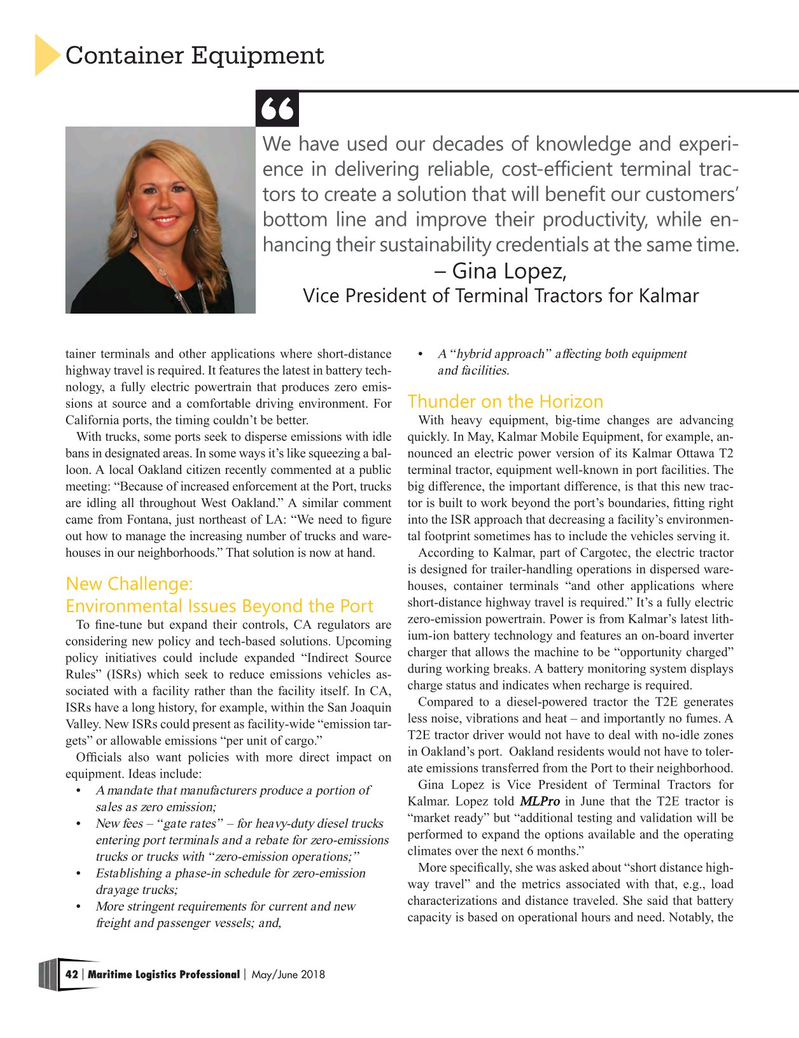
Page 42: of Maritime Logistics Professional Magazine (May/Jun 2018)
Container Ports
Read this page in Pdf, Flash or Html5 edition of May/Jun 2018 Maritime Logistics Professional Magazine
Container Equipment
We have used our decades of knowledge and experi- ence in delivering reliable, cost-efficient terminal trac- tors to create a solution that will benefit our customers’ bottom line and improve their productivity, while en- hancing their sustainability credentials at the same time.
– Gina Lopez,
Vice President of Terminal Tractors for Kalmar tainer terminals and other applications where short-distance • A “hybrid approach” affecting both equipment highway travel is required. It features the latest in battery tech- and facilities.
nology, a fully electric powertrain that produces zero emis- sions at source and a comfortable driving environment. For
Thunder on the Horizon
California ports, the timing couldn’t be better. With heavy equipment, big-time changes are advancing
With trucks, some ports seek to disperse emissions with idle quickly. In May, Kalmar Mobile Equipment, for example, an- bans in designated areas. In some ways it’s like squeezing a bal- nounced an electric power version of its Kalmar Ottawa T2 loon. A local Oakland citizen recently commented at a public terminal tractor, equipment well-known in port facilities. The meeting: “Because of increased enforcement at the Port, trucks big difference, the important difference, is that this new trac- are idling all throughout West Oakland.” A similar comment tor is built to work beyond the port’s boundaries, ftting right came from Fontana, just northeast of LA: “We need to fgure into the ISR approach that decreasing a facility’s environmen- out how to manage the increasing number of trucks and ware- tal footprint sometimes has to include the vehicles serving it.
houses in our neighborhoods.” That solution is now at hand. According to Kalmar, part of Cargotec, the electric tractor is designed for trailer-handling operations in dispersed ware-
New Challenge: houses, container terminals “and other applications where short-distance highway travel is required.” It’s a fully electric
Environmental Issues Beyond the Port
To fne-tune but expand their controls, CA regulators are zero-emission powertrain. Power is from Kalmar’s latest lith- considering new policy and tech-based solutions. Upcoming ium-ion battery technology and features an on-board inverter policy initiatives could include expanded “Indirect Source charger that allows the machine to be “opportunity charged” during working breaks. A battery monitoring system displays
Rules” (ISRs) which seek to reduce emissions vehicles as- sociated with a facility rather than the facility itself. In CA, charge status and indicates when recharge is required.
Compared to a diesel-powered tractor the T2E generates
ISRs have a long history, for example, within the San Joaquin less noise, vibrations and heat – and importantly no fumes. A
Valley. New ISRs could present as facility-wide “emission tar-
T2E tractor driver would not have to deal with no-idle zones gets” or allowable emissions “per unit of cargo.”
Offcials also want policies with more direct impact on in Oakland’s port. Oakland residents would not have to toler- ate emissions transferred from the Port to their neighborhood.
equipment. Ideas include:
Gina Lopez is Vice President of Terminal Tractors for • A mandate that manufacturers produce a portion of
Kalmar. Lopez told MLPro in June that the T2E tractor is sales as zero emission; “market ready” but “additional testing and validation will be • New fees – “gate rates” – for heavy-duty diesel trucks performed to expand the options available and the operating entering port terminals and a rebate for zero-emissions climates over the next 6 months.” truc ks or trucks with “zero-emission operations;”
More specifcally, she was asked about “short distance high- • Establishing a phase-in schedule for zero-emission way travel” and the metrics associated with that, e.g., load dr ayage trucks; characterizations and distance traveled. She said that battery • More stringent requirements for current and new capacity is based on operational hours and need. Notably, the fr eight and passenger vessels; and, 42 Maritime Logistics Professional May/June 2018 | |

 41
41

 43
43
